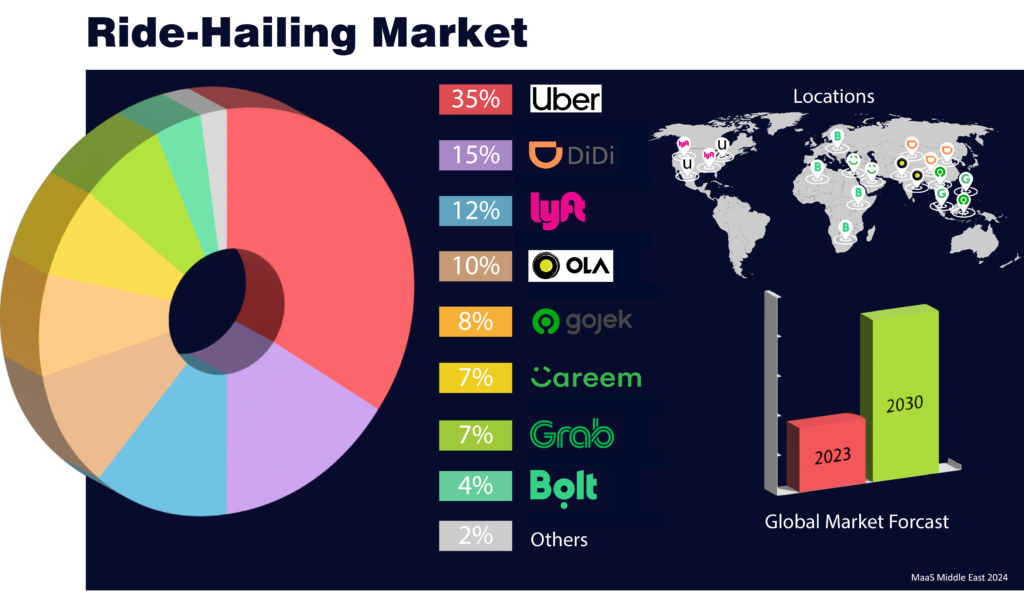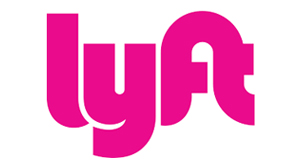The ride-hailing industry has transformed the urban transportation landscape in a relatively short period. These app-based mobility services offer on-demand rides, connecting passengers with drivers through a user-friendly platform. Convenience, affordability, and reduced reliance on personal car ownership are some of the key factors driving the immense popularity of ride-hailing services around the world.
This article explores the current and projected size of the ride-hailing market, focusing on its value and the estimated number of trips completed globally. Additionally, we’ll delve into the background and reach of eight prominent ride-hailing companies shaping the industry today.
Ride-hailing Market Size
The global e-hailing market is experiencing significant growth, fueled by increasing urbanization, smartphone penetration, and a growing preference for convenient and flexible transportation options.
The global ride-hailing market size was valued at USD 70 billion in 2023. It is estimated that the total revenues from hailed mobility could exceed USD 450 billion by 2030.
These figures paint a clear picture: the ride-hailing market is booming and shows no signs of slowing down. As urbanization continues and people seek alternative transportation solutions, the demand for ride-hailing services is expected to surge in the coming years.

Top Ride-Hailing Companies in the World
The ride-hailing landscape is populated by several major players, each with a unique footprint and market share. Here’s a closer look at eight of the most prominent ride-hailing companies worldwide:
1- Uber

- Origin: United States
- Locations Served: Over 95 countries and territories worldwide.
- Market Share: While Uber remains a major player, its market share has fluctuated in recent years due to competition. Estimates suggest it holds the largest global market share of 35%
- Background: Founded in 2009 in San Francisco, Uber is arguably the most recognizable name in ride-hailing globally. It pioneered the app-based ride-hailing model and has since expanded to offer various services beyond traditional ride-sharing, such as Uber Eats (food delivery) and Uber Freight (logistics).
2- Didi Chuxing

- Origin: China
- Locations Served: Primarily operates in China, with limited international presence.
- Market Share: Holds a dominant market share within China, and global market share estimated to be around 15%.
- Background: Established in 2012, Didi Chuxing is the dominant ride-hailing company in China, the world’s most populous country. Didi acquired Uber China in 2016, solidifying its position within the Chinese market.
3- Lyft

- Origin: United States
- Locations Served: Primarily operates in the United States and Canada.
- Market Share: Lyft holds a significant market share in North America, global market share estimated to be around 12%.
- Background: Launched in 2012 in San Francisco, Lyft is a major competitor to Uber in North America, known for its focus on eco-friendly initiatives and driver partnerships.
4- Ola

- Origin: India
- Locations Served: Primarily operates in India, with a limited presence in other South Asian countries and Australia.
- Market Share: Holds a dominant market share in India, global market share estimated to be around 10%.
- Background: Founded in 2011, Ola Cabs (commonly known as Ola) is the leading ride-hailing platform in India. It offers various ride-hailing options catering to different budgets and vehicle types
5- Go-Gek

- Origin: Indonesia
- Locations Served: Primarily operates in Southeast Asia, including Indonesia, Singapore, Vietnam, Thailand, and the Philippines.
- Market Share: Holds a significant market share in Southeast Asia, particularly in Indonesia. Global market share is estimated to be around 8%.
- Background: Established in 2010 in Indonesia, Go-Jek began as a motorcycle ride-hailing service and has since transformed into a comprehensive super-app offering various on-demand services like ride-hailing, food delivery, payments, and more.
6- Careem

- Origin: Dubai, United Arab Emirates
- Locations Served: Primarily operates in the Middle East and North Africa region.
- Market Share: Prior to the Uber acquisition, Careem held a leading market share in the MENA region. Global market share is estimated to be around 7%.
- Background: Founded in 2012 in Dubai, Careem was a major ride-hailing player in the Middle East and North Africa region. In 2019, Uber acquired Careem, though the company continues to operate as a separate entity focusing on the MENA region.
7- Grab

- Origin: Malaysia
- Locations Served: Primarily operates in Southeast Asia, including Malaysia, Singapore, Indonesia, Thailand, Vietnam, and the Philippines.
- Market Share: Holds a significant market share in Southeast Asia, particularly in Singapore. Global market share is estimated to be around 7%.
- Background: Established in 2012 in Malaysia, Grab is a leading ride-hailing and super-app platform in Southeast Asia, offering services similar to Go-Jek, including ride-hailing, food delivery, payments, and more.
8- Bolt

- Origin: Estonia
- Locations Served: Operates in over 40 countries and over 100 cities primarily across Europe and Africa.
- Market Share: While not a dominant player globally, Bolt holds a notable market share in several European and African countries, particularly in its core markets of Eastern Europe and Africa. Its global market share is estimated to be around 4%.
- Background: Founded in 2013 in Estonia (originally known as Taxify), Bolt is a rapidly growing European ride-hailing company known for its focus on competitive pricing and transparency.
Factors Influencing the Future of Ride-hailing
Several crucial factors are expected to further propel the growth of the ride-hailing market in the coming years:
Technological advancements: The continued development of self-driving cars and autonomous vehicle technology could significantly impact the ride-hailing industry. Autonomous vehicles have the potential to disrupt the current model and potentially reduce costs associated with drivers.
Focus on sustainability: Concerns about environmental impact are driving a shift towards electric vehicles (EVs) within the ride-hailing industry. Many companies are implementing eco-friendly initiatives like offering EV ride options to reduce their carbon footprint.
Regulatory landscape: Government regulations play a crucial role in shaping the ride-hailing industry. Clear and consistent regulations are essential for ensuring the safety and well-being of both passengers and drivers.
The ride-hailing market is at a pivotal juncture, brimming with potential and facing exciting challenges with advancements in technology and changing consumer preferences. As the industry unfolds, it will be fascinating to witness how these factors influence the landscape and reshape the way we move around our cities.





